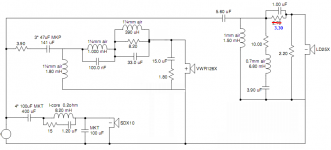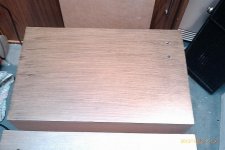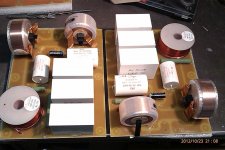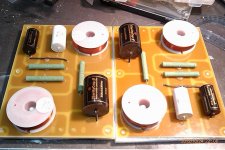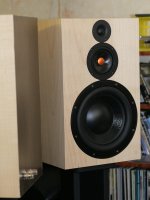why would that be if the mic is on the floor?
Check your cited book on the effective range of a ground plane measurement, and the attendant tilt you have incorporated. Then do the math on the reflection path you have created by raising the baffle above the very surface you are trying to use as a ground plane.
You have incorporated some good ideas here, but the lift off of the floor is not one of them.
You may have in mind that you will be using these enclosures off of the floor, fine and well, but then you should be testing them in a much different manner. The important points are in chapter 5 page 71 on.
You have a great design idea, good enclosure ideas, and a fairly well thought out crossover. Measurement is not easy to get right I know from experience. It is indeed very easy to get wrong.
His measurements are fine. They just show some reflections near the mic. Because of this some smoothing is needed. Page 63 of the book describes ground plane and he's done it right. It's just uncommon to see. And it needs the mic to be "flush" with the ground. Which it never can be.
raising the LOT above the ground is also in dr Joe's book and is intended to get the correct baffle step in, placing a loudspeaker on the floor which would normally be on a stand would "create" a larger baffle that would not give the right response (as iirc is also shown in the book). next time either find a way to reduce the floor reflections or use 2 measurements (ground plane and normal gated) and "glue" them together (or just accept the measurement as it is, since with some smoothing the basic curve looks the same as is indicated in post #24 )
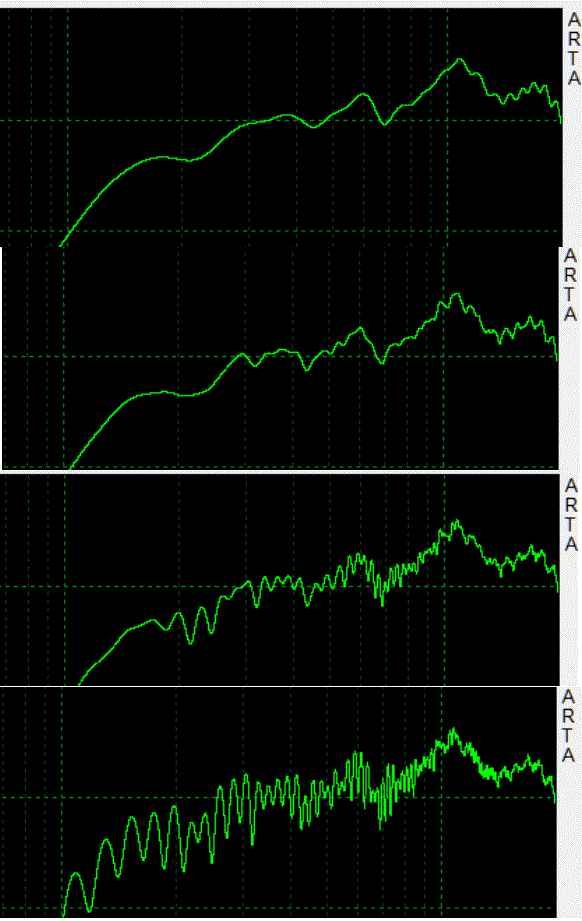
which should be "good enough" for initial filter design

which should be "good enough" for initial filter design
Yes you have the correct idea. Some ground plane, and some near field stitched together. The use of gating alone in a very reverberant room will not get you a clean response. But you are perfectly correct in stating that it is enough for crossover work.
Still think they will sound great. Better by leaps and bounds what was available in the 70s and 80s.
Still think they will sound great. Better by leaps and bounds what was available in the 70s and 80s.
Sometimes smoothing will approximate nicely to what a properly gated measurement will provide, but a lot of the time it does not. Usually reflected high frequency data data will smooth nicely, the real trouble comes with smoothing out peaks in the 100-500Hz range, give or take. At high frequencies, as the wavelengths are short, you tend to get a reflection containing a spread of frequencies and it averages out nicely. At lower frequencies though you get modal room interaction and reflections such as floor bounce coming in and these do not tend to average out anywhere near as well.
Personally I like to use reasonably short gated far field measurements, combined with a near field measurement + bafflestep estimation. Usually the far field measurement extends low enough to capture all of the diffraction ripple and the start of bafflestep, with the simulated bafflestep, added to the near field measurement, taking over nicely to complete the picture. This obviously has its drawbacks, such as designs with semi floor loaded woofers, but that kind of thing really needs to be balanced in room, just as bafflstep does anyway.
Personally I like to use reasonably short gated far field measurements, combined with a near field measurement + bafflestep estimation. Usually the far field measurement extends low enough to capture all of the diffraction ripple and the start of bafflestep, with the simulated bafflestep, added to the near field measurement, taking over nicely to complete the picture. This obviously has its drawbacks, such as designs with semi floor loaded woofers, but that kind of thing really needs to be balanced in room, just as bafflstep does anyway.
progress at last 
(I was ill for almost a month (salmonella caught me), so more than happy to continue)
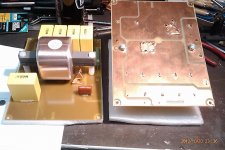
I have not been all quiet, during the days I felt well enough, I started with an amp to match these: a Hypex ncore. realy a great amp only disadvantage is that now I want to upgrade the rest of my set as well
only disadvantage is that now I want to upgrade the rest of my set as well 
(I was ill for almost a month (salmonella caught me), so more than happy to continue)

I have not been all quiet, during the days I felt well enough, I started with an amp to match these: a Hypex ncore. realy a great amp
 only disadvantage is that now I want to upgrade the rest of my set as well
only disadvantage is that now I want to upgrade the rest of my set as well 
what exactly are you looking for? (if it's measurements of the complete box, you'll have to be patient for a little while, I want to enjoy someSo, give us a review of the results!

 music
music 
 first)
first)great tweeter, very well built, integrates seamless with the VWR126X, clean upto neighbour unfriendly levelsAnd your opinion of the LDX25?
2 reasons: #1 was not available when I started the build, and #2 it's too big for this boxWhy did you not go with the waveguide?
yes, very happy.
a review (I'm no good in this):
the short version: the best speakers I have built or owned. period.
the long version: this thing does it all: imaging at least as good as a good full range (singers are as real as if they are in the room), deep and punchy bass (drums are alive), powerfull sound, clean also at very high levels (no fatique at all), revealing every detail in the music but also every shortcoming in the rest of the chain (these are the reason I built an Hypex ncore amp and I am going to upgrade my DAC to a Sabre).
a review (I'm no good in this):
the short version: the best speakers I have built or owned. period.
the long version: this thing does it all: imaging at least as good as a good full range (singers are as real as if they are in the room), deep and punchy bass (drums are alive), powerfull sound, clean also at very high levels (no fatique at all), revealing every detail in the music but also every shortcoming in the rest of the chain (these are the reason I built an Hypex ncore amp and I am going to upgrade my DAC to a Sabre).
That is good news, indeed. The LD25X tweet is really a gem, says Jeff B., and I agree with him. I do not need to look further with this quality already here and ready to use.
I am not good at those reviews either as my knowledge is limited in sharing my thoughts, but I try.
So, would you care to compare with what speakers you have "build or owned" with the Heavyweight?
Sounds like you are very happy with your build. I am very curious as a friend and myself are looking for a build like this or similar, (as I mentioned) with plenty of bass and with the tweet and of course the mid. I love the wide range woofer, so I guess I can say....the whole CSS line of XBL speakers. We just can't do the speaker designing thang.
Could you elaborate on "the reason you build the Hypex Ncore Amp"? Why this type of speaker?
Thanks
I am not good at those reviews either as my knowledge is limited in sharing my thoughts, but I try.
So, would you care to compare with what speakers you have "build or owned" with the Heavyweight?
Sounds like you are very happy with your build. I am very curious as a friend and myself are looking for a build like this or similar, (as I mentioned) with plenty of bass and with the tweet and of course the mid. I love the wide range woofer, so I guess I can say....the whole CSS line of XBL speakers. We just can't do the speaker designing thang.
Could you elaborate on "the reason you build the Hypex Ncore Amp"? Why this type of speaker?
Thanks
- Status
- This old topic is closed. If you want to reopen this topic, contact a moderator using the "Report Post" button.
- Home
- Loudspeakers
- Multi-Way
- all CSS heavyweight compact 3way
